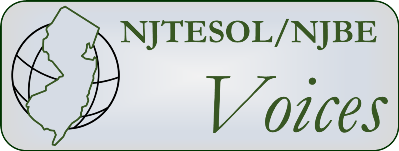NJ Teachers of English to Speakers of Other Languages/
NJ Bilingual Educators
ARTICLES
Editor: Lisa Rose Johnson- From the Editor: Support for Teachers
President: Caia Schlessinger- Changes to NJTESOL/NJBE Membership
Vice-President: Margaret Churchill- Equity Resources
Past President: JoAnne Negrin- Words of Encouragement & Social Media Resources
Technology Coordinator: Marilyn Pongracz- Memo about the Hotlist
Business Administrator: Gwen Franks- 2020 Spring Conference Refunds
Advocacy: Elizabeth Franks- Advocacy Report
Historian: Barbra Tedesco- The Power of an Idea: An ESL Teachers Book Club
Exhibitor Liaison: Tina Kern- Teaching Virtually: Filling the Gap
Liaison: LeighAnn Matthews- Supporting and Advocating for Emerging Bilinguals in the Content Areas
Representative at Large: Alamelu Sundaram-Walters- COVID 19 & Distance Learning: How to find time for Self-Care
Technology Coordinator: Marilyn Pongracz- Favorite Website: Nearpod
Guest Contributor: Natasha Agrawal- Inspirational Egypt: Umm El Doniya
Guest Contributor: Jeffrey Linn- What does “to” mean? Why do the little words matter?
From the Editor
Support for Teachers
Dr. Lisa Rose Johnson, Ed.D.
Hello Members,
 It is hard to imagine that the last time I sat down to write for Voices it was still 2019. Now as I write to you, we are well into 2020 and what a year it has been thus far. I know myself and many members were recently asked to step out of our comfort zone with regard to how we perform the duties within our profession. I can imagine that many of our members at this moment are working to create and find suitable materials for virtual learning. This as you know is due to social distancing policies that keep us from our classroom and students. As many schools head into Spring Break, the Spring 2020 issue of Voices has much to offer you the reader during this down time from teaching. Many of our Special Interest Group Representatives (SIG Reps.) are sharing some of their favorite free online resources for both academic lessons and self-care so be sure to read outside of your SIG if you have not done that in the past.
It is hard to imagine that the last time I sat down to write for Voices it was still 2019. Now as I write to you, we are well into 2020 and what a year it has been thus far. I know myself and many members were recently asked to step out of our comfort zone with regard to how we perform the duties within our profession. I can imagine that many of our members at this moment are working to create and find suitable materials for virtual learning. This as you know is due to social distancing policies that keep us from our classroom and students. As many schools head into Spring Break, the Spring 2020 issue of Voices has much to offer you the reader during this down time from teaching. Many of our Special Interest Group Representatives (SIG Reps.) are sharing some of their favorite free online resources for both academic lessons and self-care so be sure to read outside of your SIG if you have not done that in the past.
I also would like to share a few resources that I found to be useful myself as an educator and teacher educator. As a consumer of social media, I prefer Facebook as a platform. One public group that I found to be helpful and often turn to support for is the Educator Temporary School Closure Community. What I find most interesting is that this community is made up of educators from international schools in places like China and Italy as well as members from public schools in all fifty states. I find that this group is a refreshing place to see that education is going on worldwide and includes so many caring and supportive professionals who are sharing best practices as well what was not working.
A second group that you might consider joining that is also public is the Dual Language Online Learning Group . This group provides supports to both bilingual and world language educators who are now tasked with providing instruction online.
I also am a member of the American Education Research Association Division K (AERA-Division K Teacher Education) which also can be a great forum if you want a more research based spin. Much like many public schools who have made the transition to online learning, many colleges and universities have followed the same path and there may be some good resources on that page as well.
I can only hope that our summer issue will have an upbeat spin and that we will continue to share our success with regard to advocating for emergent bilingual populations in New Jersey.
Dr. Lisa Rose Johnson, Ed.D, is the editor of Voices and also serves as the Teacher Education Representative. She works at Rowan University in the Teachers of Students with Disabilities (TOSD) Program.
Changes to NJTESOL/NJBE Membership
By Caia Schlessinger
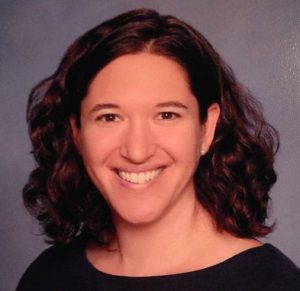 As President of NJTESOL/NJBE, I am proud of the resources and support that we make available to our membership. Our members can choose to participate in the hotlist, which is an e-mail discussion list through which members can read about employment opportunities, workshop and conference announcements, questions about state laws and standards, advice, best practices, material searches, testing questions, and advocacy. Recently, the hotlist has been an excellent resource for educators planning online learning for their students. Our hotlist moderator and Technology Coordinator, Marilyn Pongracz, has been compiling these resources on the Online Teaching Resources page under Links on our website. In addition to the hotlist, our members receive this quarterly online Voices newsletter, which helps our members stay informed about the latest issues, news, and happenings in bilingual, dual language, and ESL education in our state. The current issue is only available to our membership.
As President of NJTESOL/NJBE, I am proud of the resources and support that we make available to our membership. Our members can choose to participate in the hotlist, which is an e-mail discussion list through which members can read about employment opportunities, workshop and conference announcements, questions about state laws and standards, advice, best practices, material searches, testing questions, and advocacy. Recently, the hotlist has been an excellent resource for educators planning online learning for their students. Our hotlist moderator and Technology Coordinator, Marilyn Pongracz, has been compiling these resources on the Online Teaching Resources page under Links on our website. In addition to the hotlist, our members receive this quarterly online Voices newsletter, which helps our members stay informed about the latest issues, news, and happenings in bilingual, dual language, and ESL education in our state. The current issue is only available to our membership.
Recently, there have been some changes to our membership policies and I am excited to share them with all of you. First of all, a one year NJTESOL/NJBE membership is now a gift of the organization to all who paid to attend the 2020 Spring Conference. Yearly membership started when the conference registration form & payment (personal check, approved & signed purchase order or online payment) was received & processed. If you were already a current member, your membership has been extended for one year from your date of expiration. If you did not register for the 2020 Spring Conference or need to renew/join now there are two ways you can pay for membership – by mail with this printable registration form or online. Even though the Spring Conference has been cancelled because of the current COVID-19 restrictions, NJTESOL/NJBE will still honor the membership that was purchased as part of the registration fee.
NJTESOL/NJBE is also pleased to offer the Faculty Recommended Free One Year NJTESOL/NJBE Membership for Current College Students. NJTESOL/NJBE is offering a free, one-year student membership. Eligible students must be either full or part-time students who have never been a NJTESOL/NJBE member in the past. Students must be recommended by one of their professors using this form. The Executive Board is currently discussing the possibility of a Retiree Membership – stay tuned!
If you have any questions about membership, please contact the Membership Chair, Joan Pujol at mmbr@njtesol-njbe.org
Caia Schlessinger is the President of NJTESOL/NJBE and an ESL Teacher in the Highland Park School District.
Equity Resources
By Maggie Churchill, Vice President
 For this issue, I thought I would share some practical, hands-on resources that teachers of emergent bilinguals can readily use in their equity work with students, families, paraprofessionals, teachers, administrators, and stakeholders. Please enjoy and share!
For this issue, I thought I would share some practical, hands-on resources that teachers of emergent bilinguals can readily use in their equity work with students, families, paraprofessionals, teachers, administrators, and stakeholders. Please enjoy and share!
Ensuring English Learner Students Can Participate Meaningfully and Equally in Educational Programs, U.S. Department of Education & the Office for Civil Rights
This is a succinct guidance document that outlines federal law as it relates to the educational rights of English language learners.
https://www2.ed.gov/about/offices/list/ocr/docs/dcl-factsheet-el-students-201501.pdf
Teaching Tolerance: Guide to Serving ELL Students and Families
Developed from Critical Practices in Anti-Bias Education, this comprehensive guide provides explicit strategies to engage ELLs and their families through the establishment of a classroom culture, social inclusion for ELLs, celebrating multiculturalism, communicating with families, and building a district-wide system of language access services.
https://www.tolerance.org/magazine/publications/serving-ell-students-and-families
CUNY-NYSIEB Translanguaging Guide for Educators
It covers instructional foundations for establishing translanguaging-friendly classrooms, strategies for instructional delivery, content and literacy development, language development, and resources.
https://www.cuny-nysieb.org/wp-content/uploads/2016/04/Translanguaging-Guide-March-2013.pdf
Social Justice Radical Library
Created by former NJTESOL/NJBE Executive Board member, Joyce Farr, this Google site is a repository of social justice stories, book resources, a media library, and recommended publishers. This site is meant to be shared with colleagues and administrators.
https://sites.google.com/view/joisse/radical-library-home
A Culturally Responsive Guide to Fostering the Inclusion of Immigrant-Origin Students
Available at Re-Imagining Migration, a website
This is a comprehensive guide developed at UCLA that address a range of needs currently facing our ELLs; from social-emotional needs to language-learning issues, to best practices for SIFEs, to using murals as teaching tools, and suggestions for equity-based texts that link to curricular themes.
https://reimaginingmigration.org/wp-content/uploads/2018/07/Inclusive-Curriculum-V9-24Sept2018.pdf
Maggie Churchill is the current Vice President and Conference Chair for NJTESOL/NJBE.
Words of Encouragement & Social Media Resources
(This is a reprint from our hotlist, in case you missed it.)
By JoAnne Negrin
Dear Colleagues,
 First of all, I want to congratulate you and salute you for your heroism and spirit. You have moved mountains over the last few weeks, overcoming personal fears and multiple competing obligations to ensure that your students get the best education you can provide. Some of you already had robust online resources, and others had to undergo baptism by fire. You are all amazing.
First of all, I want to congratulate you and salute you for your heroism and spirit. You have moved mountains over the last few weeks, overcoming personal fears and multiple competing obligations to ensure that your students get the best education you can provide. Some of you already had robust online resources, and others had to undergo baptism by fire. You are all amazing.
Now that we are two weeks in, you probably have your feet on the ground at least a little, and hopefully, you’re feeling a little less overwhelmed. Right now is a scary time, and educators are worried about so many things. Now is the time when all stakeholders can rise to the challenge, and look at this as an opportunity to learn new skills.
I see some teachers and districts trying to teach the whole curriculum, every bit, every assignment. Others are obsessing about what will happen with testing. I see these responses as the educational equivalent of hoarding toilet paper. You’re trying to exert control over an uncontrollable event. Allow me, if I may, to ask you to focus first and foremost on making your students feel safe and secure in their virtual classroom, and provide an environment that they can look forward to interacting with each day. That means paring down your lessons and expectations. What is essential? Remember that the entire world is going to be behind on the curriculum next year. We will pick up, figure out where every student is, and meet their needs as we always do. Of that, there is no question. In the meantime, what part of your daily rituals can be transferred online? Did you use morning meetings as part of your teaching? Did you always start by talking about the date and the weather? Do that now. Or ask people to share the funniest thing that happened to them. Or to share a picture of their pets or their bedroom slippers. They’re little things that mean a lot.
Also, do your best to make it engaging and fun. I’ve seen high school ESL teachers who are teaching Of Mice and Men have students read the text, watch Kid President videos, and draw comparisons. Other teachers dove into resources like FlipGrid and Seesaw. I like having students create comic strips with Storyboard That. They can do voiceovers using Screencastify. There are so, so many options out there that we can use to make things engaging. Don’t feel you need to conquer all of it. Pick one or two things that work for you. If you think you’ve mastered them and need a new mountain to climb, then incorporate more if you like.
As a planner, try to find economies of scale. One thing I’ve seen teachers do successfully is to use the same primary source, such as a video, and then scaffold the assignment for different levels, rather than finding different things for everyone. That’s utterly legit from an educational perspective and can help save your sanity. This is going to be a marathon. Don’t come off the starting line too fast. If you feel you are losing your curiosity, you’re doing too much, and you need to find some hacks.
Oh, and one more thing…try to avoid synchronous communication. If you do plan on having, say, a 10 am Zoom meeting, record it, and post it in your classroom for students to view later. This way, if students don’t understand and need to review, they can. It also helps families in which multiple students share a device. Older students may feel added pressure to support their families economically, and $17 an hour for warehouse or delivery work is a huge draw. These students may need additional flexibility.
Finally, I think that social media is a great place to be right now. If you’ve eschewed it to this point or are afraid that your students or the people you didn’t really like in high school are going to try to connect with you, then use an alias and don’t friend anyone. You can then use this alias to join some great conversations that are happening there.
Below I have included some handy web pages and groups that I recommend you search out. These are all on the platform Facebook. I find that platform the most useful because it contains the most substantial cross-section of people. However, other platforms also provide helpful information, including Judie Haynes’ #ELLCHAT on Twitter. Many entities have a presence across multiple platforms. Go with what works for you.
Facebook pages and groups worth checking out:
- NJTESOL/NJBE (of course!)
- Borderless Learning (disclaimer – this is my page. It’s not commercial at all. It just makes me feel productive when I’m really procrastinating)
- LingEducator I Linguistic Resources For Those Who Teach
- Reclaiming the Language for Social Justice
- Dual Language Online Learning
- Advocating for ELLs
- Educator Temporary School Closure for Online Learning
Of course, there are more, but these are among the best. If you only look at these, you’ll have plenty.
You can also create a closed group for just your colleagues (make it closed, but not a private group so that it can be searched.) The beautiful thing about a closed group is that the individuals in the group don’t need to be connected to one another to participate. I have one for my ESL, World Languages, and Bilingual staff, and about 50 of them are in it. It makes it so much easier to share information.
Finally, and most importantly, remember that you are a lifeline, you are a light, you are making an actual difference in your students’ lives. You’re giving them a reason to get up in the morning. You might be the highlight of their day.
And think of the bragging rights you will have when this is over!
Hang in there. You’ve got this!
JoAnne Negrin is the NJTESOL/NJBE Past-President
Memo about the Hotlist
By Marilyn Pongracz
Participation
 Many of you registered for the conference, but participation in the hotlist was not checked. If you want to receive messages and participate in discussions about best practices, resources, testing, advocacy, employment opportunities, workshop and conference announcements, and questions about state laws and standards, let us know, and we can add your email to the NJTESOL/NJBE hotlist.
Many of you registered for the conference, but participation in the hotlist was not checked. If you want to receive messages and participate in discussions about best practices, resources, testing, advocacy, employment opportunities, workshop and conference announcements, and questions about state laws and standards, let us know, and we can add your email to the NJTESOL/NJBE hotlist.
Blocked Messages
Most email providers, except Gmail, have increased their security, so some messages may not come through to everyone. To be sure they do, please do not send messages with images or attachments. Clean messages that are typed directly into the email are better than those copied from Word.*
Avoid words like hello and everyone although hi is fine. Also try to avoid business words such as approved or important, especially in the subject.
*If you have a computer with Windows, you can copy and paste any text into Notepad and from Notepad, copy and paste it into your email, and it will be clean, having minimal code. Notepad can be found under Windows Accessories.
*On a Mac, you can use TextEdit by setting the preferences to Plain Text.
Marilyn Pongracz is the NJTESOL/NJBE Technology Coordinator.
2020 Spring Conference Refunds
By Gwen Franks
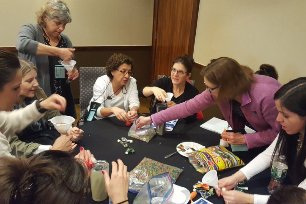 As a result of the unfortunate COVID-19 health crisis, and after much deliberation, we feel there is no alternative but to announce the cancellation of our May 27-29, 2020 NJTESOL/NJBE Annual Spring Conference, Equity for ELs, which was to take place at the Hyatt Hotel in New Brunswick.
As a result of the unfortunate COVID-19 health crisis, and after much deliberation, we feel there is no alternative but to announce the cancellation of our May 27-29, 2020 NJTESOL/NJBE Annual Spring Conference, Equity for ELs, which was to take place at the Hyatt Hotel in New Brunswick.
Registration for the conference was on track for another successful year with over 1050 already registered as of March 13th. We ask that you please be patient with us in this cancellation process.
All FULL refunds will be in the same payment method used when you registered.
NJTESOL/NJBE will begin to process refunds in the following order:
- Registrants who paid by personal check*
- Registrants who paid online with a credit card/PayPal Account
- Exhibitors/Sponsors who paid by check*
- Exhibitors/Sponsors who paid online with a credit card/PayPal Account
- Registrants whose registration was paid by a school purchase order**
* If the check was cashed, NJTESOL/NJBE will write & mail a check to you. If your check was not cashed it will be voided out.
** Purchase orders – will be voided out and returned (if necessary) to your district office. If your district sent a check for the PO and it was already cashed, we will send a check from NJTESOL/NJBE. If the check was not cashed, it will be voided and sent back to the district office.
Thank you in advance for your patience as we work to give a full refund for all registrations/exhibitors in a timely manner.
If you should have any questions about refunds please cancel me at gfranks@njtesol-njbe.org.
Respectfully,
Gwen
Gwen Franks
Business Administrator
NJTESOL/NJBE, Inc.
Gwen Franks is the business administrator and a conference planner for NJTESOL/NJBE.
Advocacy Report
By BJ Franks
 Stay connected and stay safe! Our children and families need your advocacy now more than ever.
Stay connected and stay safe! Our children and families need your advocacy now more than ever.
On that note, February was a busy month for NJTESOL/NJBE. Here are a few of the projects we are working on.
1. Representatives from NJTESOL/NJBE presented to the Executive County Superintendents and Abdul Saleem Hasan who is the Assistant Commissioner of Field Services for the New Jersey Department of Education. While at this meeting, we advocated for Equity in Career and Technical Education programs. Our next meeting was with Peggy McDonald (Assistant Commissioner – Student Services), Linda Eno (Assistant Commissioner – Academics), and Leslie Franks-McRae (Director of Office of Supplemental Educational Programs) on March 11. Our conversation continued on ways to collaborate with the County Career and Technical Organizations on our concerns.
2. BJ Franks represented NJTESOL/NJBE at the NJASCD Early Childhood Conference and advocated for the alignment of Preschool Dual Language Learners (DLL) programs with district Kindergarten programs. We suggested to Tonya Coston (Deputy Assistant Commissioner – Early Childhood Education) that the NJDOE create a virtual conference for Preschool and DLLs, similar to what they created for general educators.
3. With regard to Teacher Education, NJTESOL/NJBE is encouraging secondary schools to advance Teacher Academies or coursework for teacher education and encourage students to pursue the Seal of Biliteracy simultaneously. Our organization would like to develop a blueprint for any school with future teacher clubs to encourage students to pursue the Seal of Biliteracy. We were scheduled to attend the NJ Association of College Admission Counseling (NJACAC) on May 18-19, however, it was understandably canceled. We will work in conjunction with Foreign Language Educators of NJ (FLENJ) to maintain a partnership with NJACAC for future endeavors. We have also reached out to the Director of Future Educators at The College of New Jersey (TCNJ) in order to explore ways to partner with them to advance the need for Bilingual educators.
4. Speaking of the Seal of Biliteracy, FLENJ is partnering with NJTESOL/NJBE on The Pathways to Biliteracy and Dual Language networks. The next meetings for these initiatives were scheduled for late April. However, they both have been postponed for a future date to be determined. In the Dual Language Network, we are hoping to work with two representatives from the Teacher Certification Office, Tonya Coston from the Early Childhood office plus Jacquelyn “Jackie” León from the Bilingual Office. The Dual Language Network has been contemplating plans to design an EdCamp. .
Unfortunately, the Pathway to Biliteracy decided to postpone this initiative until next year. We made great progress in creating Speaking and Writing prompts that will be used for 8th graders to demonstrate their biliteracy skills. We, at least, will have a strong starting point for next year. We want to thank Amanda Seewald, Dana Pilla and Michele Schreiner from FLENJ for their collaboration in both of these projects and hope to continue this strong partnership.
Legislatively, these are the current bills that are pending:
1. Rep. Raúl M. Grijalva introduced H.R. 5764 the Supporting Young Language Learners’ Access to Bilingual Education (SYLLABLE) Act in the House of Representatives. The bill helps establish high-quality dual language immersion programs in communities with high numbers of low-income families and supports those programs from pre-K to 5th grade.
2. Federally, Reach English Learners Act was reintroduced (HR1153; S545) that will establish a grant program to fund certifying more teachers to work with ELs. New Jersey Representatives Albio Sires and Frank Pallone have signed on as co-sponsors. Please write to your Representative and Senators and urge them to co-sponsor the bill. Let them know that the EL population in NJ is growing and we need more ESL certified and Bilingual certified teachers. New Jersey would definitely benefit from this grant program. Check https://njtesol-njbe.org/advocacy/ for contact information.
3. Another bill that is in the Committee phase is HR1094 World Language Advancement and Readiness Act of 2019.“The Secretary of Defense, in consultation with the Director of National Intelligence and the Secretary of Education, shall carry out a program under which the Secretary of Defense makes grants, on a competitive basis, to State educational agencies and local educational agencies to pay the Federal share of the cost of innovative model programs providing for the establishment, improvement, or expansion of world language study for elementary school and secondary school students. Albio Sires is the only NJ co-sponsor of this bill.
4. The BEST Act: HR 3119 and S 3328 To further promote biliteracy across the country, the BEST Act would authorize $10 million to award grants to states to establish, improve, and implement Seal of Biliteracy programs. Endorsing organizations include the Joint National Committee for Languages—National Council for Languages and International Studies, National Association for Bilingual Education, American Council on the Teaching of Foreign Languages, National Coalition of Native American Language Schools and Programs, and American Council on the Teaching of Foreign Languages.
BJ Franks is the Co-Manager with Barbara Tedesco of LLAMAME, LLC and the NJTESOL/NJBE Historian Socio-Political Representative
The Power of an Idea: An ESL Teachers Book Club
By Barbara Tedesco
 Do you like to read? Are you in a book club? I have always been an avid reader, but I did not participate in a book group until I learned about The ESL Teachers Book Club. The ESL Teachers Book Club originated during the NJTESOL/NJBE Spring Conference in May of 2017. Mary Curran, Ph.D., Associate Dean for Local-Global Partnerships at the Graduate School of Education (GSE) at Rutgers, The State University, presented a workshop at the conference that included the idea of a book club for ESL teachers. Dr. Curran shared information about Ann Morgan, who considered herself well-read until she discovered a “massive cultural blind spot” in her bookshelf. Amid a multitude of English and American authors, there were very few works from authors beyond the English-speaking world. So, Ann Morgan set an ambitious goal: to read one book, from every country in the world, over the course of a year.
Do you like to read? Are you in a book club? I have always been an avid reader, but I did not participate in a book group until I learned about The ESL Teachers Book Club. The ESL Teachers Book Club originated during the NJTESOL/NJBE Spring Conference in May of 2017. Mary Curran, Ph.D., Associate Dean for Local-Global Partnerships at the Graduate School of Education (GSE) at Rutgers, The State University, presented a workshop at the conference that included the idea of a book club for ESL teachers. Dr. Curran shared information about Ann Morgan, who considered herself well-read until she discovered a “massive cultural blind spot” in her bookshelf. Amid a multitude of English and American authors, there were very few works from authors beyond the English-speaking world. So, Ann Morgan set an ambitious goal: to read one book, from every country in the world, over the course of a year.
The idea of this book-challenge sparked an interest in many of our members. Many conference attendees and members of NJTESOL/NJBE agreed to join her and give it a go. Mary chose the books for the first session, set a date, picked a location, and followed up with emails. It is now 2020, almost three years later, and we just had a book club meeting on February 22nd. Some of the members are originals, and others are first-timers.
So why an ESL teachers book club? You get to meet interesting people, you get to read things you wouldn’t otherwise read, you get to eat, and it is just plain fun! Of course, there are deeper reasons for participating in these meetings. In essence, participants develop global competence and can investigate the world with understanding from multiple perspectives. Participants also communicate across differences while learning about their students, their families, their communities, and their countries.
How does our book club operate? The group started by (re)introducing ourselves, followed by Mary presenting a brief history of the book club. Next, we discuss the reading while we eat. Members are under no pressure to speak and can choose just to listen.
Participants are asked to bring a potluck dish to share, and Mary often invites guests to the meetings. The first guest was one of Mary’s Asian students because we were reading The Tea Girl of Hummingbird Lane and American Born Chinese. On another occasion, she invited Gita Varadarajan, the co-author of Save Me A Seat. Varadarajan also works as a teacher in the Princeton Public Schools. When there is no guest speaker present, Mary shows YouTube videos or other short clips related to the selected texts. Finally, the group members offer suggestions for the next meeting’s readings. Generally, we pick two or three books geared toward early elementary and/or young readers, plus books about adults with similar backgrounds.
A fantastic by-product of our book club is the growing list of books recommended by our members. The list keeps on growing! Now that is an excellent problem to have, isn’t it? (I will be honest that there are times that I simply don’t have the opportunity to read the selected book, so I will listen to an audiotape of the book instead.) As long as I keep my eyes on the road and hands on the wheel, listening to the audiotape enables me to participate in the discussion!
Past meetings were held from 12-2 at Rutgers GSE. Reminders are sent out and we are given instructions as to where to park. The next meeting will take place during the Spring Conference on Thursday, May 28, 2020 and you are enthusiastically invited to join us! The group will be discussing American Street by Ibi Zoboi, and No Woman Is No Man by Etaf Rum.
- First meeting: September 2017, at Rutgers
- Second meeting: February 2018, at Rutgers
- Third meeting: June 2018, at NJTESOL/NJBE Conference
- Fourth meeting: July 26, 2018, at Rutgers
- Fifth meeting: December 1, 2018, at Rutgers
- Sixth meeting: May 31, 2019, at NJTESOL/NJBE Conference
- Seventh meeting: July 12, 2019, at Rutgers
- Eighth meeting: October 19, 2019, at Rutgers
- Ninth meeting: February 20, 2020, at Rutgers
When the tenth meeting takes place, you are enthusiastically invited to join us!
Listed in the order of our meetings, the books that we have read so far include:
- The Tea Girl of Hummingbird Lane by Lisa See, and American Born Chinese by Gene Luen Yang.
- Save Me a Seat by Sarah Weeks and Gita Varadarajan, and The Namesake by Jhumpa Lahir.
- Anna Hibiscus by Atinuke, Amina’s Voice by Hena Khan, and Exit West by Mohsin Hamid.
- Mama’s Nightingale: A Story of Immigration and Separation by Edwidge Danticat, The Framing of Bones by Edwidge Danticat, and In the Time of the Butterflies by Julia Alvarez.
- Homegoing by Yaa Gyasi, and Behold the Dreamers by Imbolo Mbue.
- Dreamers (English and Spanish version) by Yuyi Morales, and Go, Went, Gone by Jenny Erpenbeck.
- Front Desk by Kelly Yang, and I am NOT Your Perfect Mexican Daughter by Erika Sánchez.
- Amal Unbound by Aisha Saeed, Internment by Samira Ahmed, and In the Midst of Winter by Isabel Allende.
- Teach Us Your Name by Huda Essa, The Death and Life of Aida Hernandez: A Border Story by Aaron Bobrow-Strain, and Lost Children Archive by Valeria Luiselli.
- American Street by Ibi Zoboi, and No Woman Is No Man by Etaf Rum.
As Mary always says: “Even if you have not read any of the books for our meeting, please come anyway!” If you cannot join our group, you might take the power of this idea and start your own ESL Teachers Book Club at a Chapter of NJTESOL/NJBE or at your school. In the words of Dr. Seuss: “Oh, the Places You’ll Go!”
If you are on Twitter, you should check out #ELLChat_BkClub.
I thank Mary for sharing all her PowerPoints so that I could craft this article. I want to give credit where credit is due. Thank you, Mary Curran, you are an inspiration!
Reference
Kedmey, D. & Catlett, C. (2015, November 23) Your guide to reading the world. IDEAS.TED.COM https://ideas.ted.com/your-guide-to-reading-the-world/
Barbara Tedesco is the Co-Manager with BJ Franks of LLAMAME, LLC and the NJTESOL/NJBE Historian.
Teaching Virtually: Filling the Gap
By Tina Kern, Exhibitor Liaison
 Not long ago…
Not long ago…
My new students, my Newcomers, were learning to write sentences, carefully manipulating subjects and verbs to create meaning with their new words. Eagerly, they wrote their sentences on poster paper and taped them on walls around the room. We took a walk, looking at their work and smiling faces. How far they had come from the students that clutched their backpacks uncertainly as they sat at tables, not knowing what to expect. They learned to enter class, grab their file folders, sharpen pencils and wait expectantly for their mini-lesson.
A few hours later, I faced another class, one of my intermediate Language Arts classes. They pondered over paragraphs, crafted from a graphic organizer, and filled in pertinent information. Some of these, unfortunately, were a little difficult to decipher, as they still struggled to place words in proper order, add description and finish their tasks. Learning languages was more difficult for some students and these individuals agonized over each word, phrase or clause. Their foundation was shaky. There were in intermediate classes, and the lessons were getting more complex, presupposing their mastery of basic concepts. They required mini lessons on basic composition, as the class continued with material that is more difficult.
Now…
I am directing and creating lessons for virtual learning, and my classroom is my kitchen. At first the lessons stressed strengthening skills and revisiting those concepts in need of review. Perhaps this experience is allowing me to redirect my focus and deliver some lessons that can fill in some of the gaps that our students have developed. Again, the focus is being redirected with the expectation of more time at home. I will be presenting lessons incorporating new skills and concepts. How can I accomplish all of this?
As ESL teachers we have developed lessons to reflect the expectations of the “times.” For example, in the late 70s and early 80s when English as a Second Language was first recognized as a need for our population of students, first speech teachers had been delivering the lessons. Then the field of ESL evolved and our goal was to provide lessons so that these students could participate in regular classes as soon as possible. There was little material, and the companies hastened to publish books and activities that seemed little more than reverse lessons developed from learning foreign languages. The company, Santillana, sent us books from Puerto Rico for the teachers who were bold enough to teach their students to read in Spanish, before English, reflecting the philosophy of transference. How could we teach those students who spoke no English to read a jumble of sounds and letters with no meaning to them? Later educational research would march to the sound of bilingual education and reinforce that ideology.
First our lessons revolved around vocabulary and dialogue, as the testing for ELLs showed the rise of the proficiency in listening and speaking, but reading comprehension and writing lagged slowly behind. As a result, another wave of a new ESL philosophy shook the field with the one word that still resonates: “rigorous.” We must concentrate our efforts among all of the domains, not just listening and speaking. Since our students were now recognized as part of the testing culture and not just an appendage or footnote, attention became focused upon our population, as it impacted the districts and states. This was the effect of NCLB.
Times, as usual, are changing again. We have to reevaluate what our students need at this time and how we can move them forward, as well as allowing ourselves to teach the basics so that we strengthen their English language foundation. Additionally, we continue to face new challenges. For example, with a shortage of teachers that are certified in Bilingual Education, districts are placing certificated teachers in content areas in Bilingual classes. They are certainly qualified to teach their content, but our ESL population is very diversified. Are these “new” teachers aware of the gaps and of the specialized techniques in order to create comprehensible input? Do they know how the affective filter can impede the learning from any lesson if our children who have experienced trauma are not ready to learn that day?
Presently, though, due to the circumstances, now almost all teachers will be dealing with the conundrum that ESL/Bilingual teachers have had for decades: the learning gap. “Realistically students will have learning gaps whenever they come back to school,” said Patricia Wright, executive director of the New Jersey Principals and Supervisors Association. In addition, she said, “People still have to remember this is a very emotional time. We need to understand that and be patient with learning.” How reminiscent of what our teachers experience on a daily basis with our students!
Currently, though, I am concerned with how to create my lessons so that my students continue to reach their potential and become successful in content areas, yet are able, at the same time, to go back and review more basic concepts and skills. For example, even some of my advanced students in my Bilingual Language Arts and the ESL classes do not have a grasp of the lexicon and syntax that drives our English language. Their sentences are awkward and incorrect. They cannot write what they are trying to say. They struggle over where to place some words, or even what words to use that are in their repertoire. How many times do they use the words “good”, “bad”, or “nice”? This really requires several directed lessons, but how can I integrate basic lessons into advanced lessons without sacrificing more ‘rigorous” lessons? How can I help them communicate their ideas?
Fortunately, companies (such as those that exhibit at our conference) are stepping up to help with the challenge of virtual teaching. For example, Learning A-Z is offering educators a free classroom subscription to raz-kids.com. In addition, BrainPOP offers free access to their site. A free site, www.readworks.org, has an incredible selection of nonfiction reading with accompanying vocabulary and comprehension exercises. Each student signs in with a class code and completes my assignments. I can check their progress on that site. These are just a few educational sites, among many others, that are stepping up to help us with the challenges of virtual learning. We can present our lessons with Screencastify and Screencast-o-matic, so that our students can hear our audio, as we share our screens to explain new concepts or reinforce past ones.
As I peruse the ACCESS skills, I notice – again – how the basic skills are necessary in order to attain proficiency that our students need to enter and be successful in mainstream classes. We cannot assume that our students already have a firm grasp on the foundation before they enter our higher-level classes. With the addition of new sites that are available to us without cost, we can fortify those skills with additional activities without forfeiting time allotted to the virtual lesson. We can offer links to math sites such as iKnowIt and games such as www.gamestolearnenglish.com supplementary to what we are able to teach virtually.
Now in our new virtual world, I am trying to think positively about what more I can offer to my students. I step back and look at the needs of the students. Maybe this is the time to help some of them with very explicitly presenting some grammar that needs to be emphasized, as well as going forward with more complex ideas. Why does it seem that a stigma was placed upon teaching phonics or grammar? Do we have to alter our lessons in “grammar for writing”, when the reality is the students need to be taught whatever is necessary to strengthen their skills so they can be more confident, and therefore, more successful? Perhaps going back to the basics, evaluating how they are communicating their ideas, is a positive way to deliver some lessons. Filling the gaps may be just what they need to propel them to the next step and be able to communicate with more creativity and as they convey their incredible ideas better. Maybe now is the time to reinforce these skills. Perhaps our present-day situation can become an opportunity when I have their “virtual attention” to spiral skills and reinforce those that are weak and need to be strengthened.
Above all, though we ALL will be dealing with gaps in learning, what our students will definitely remember is the care and compassion of teachers who continue to dedicate hours and hours to help our kids. When we return to our regular “normal” face-to-face teaching, our students will remember the effort we all made to be sensitive and positive at this time.
Feel free to reach out to me to share on-line resources and experiences!
Tina Kern is the current NJTESOL/NJBE Conference Exhibitor Liaison.
Supporting and Advocating for Emerging Bilinguals in
the Content Areas
By LeighAnn Matthews
Liaison, NJTESOL/NJBE
 As ESL teachers, many of us work closely with grade level and content area teachers to support our emerging bilinguals. We share student background information, proficiency levels, resources, and more, often only through email due to our busy schedules or conflicts in free time. But still, with this developing partnership, I find that content and grade level teachers are often left wondering, “what can I do?” This is when I become an advocate. It’s not good enough for me to assume I’ve done everything I could or that the teacher has done all they could. I make it a point to go into the classroom, informally observe, and plan a face to face meeting. Only then can I have a productive discussion and provide teachers with specific strategies that they can implement into their daily instruction and feel confident that they are reaching all students.
As ESL teachers, many of us work closely with grade level and content area teachers to support our emerging bilinguals. We share student background information, proficiency levels, resources, and more, often only through email due to our busy schedules or conflicts in free time. But still, with this developing partnership, I find that content and grade level teachers are often left wondering, “what can I do?” This is when I become an advocate. It’s not good enough for me to assume I’ve done everything I could or that the teacher has done all they could. I make it a point to go into the classroom, informally observe, and plan a face to face meeting. Only then can I have a productive discussion and provide teachers with specific strategies that they can implement into their daily instruction and feel confident that they are reaching all students.
While I recognize that every school and teacher has different needs, below, I share some of my top tips for content and grade level teachers so that they feel confident supporting emerging bilinguals in their classrooms. I created this list after noticing similar gaps and deficiencies in supports in multiple K-12 classrooms and content areas. I encourage you to identify trends and patterns so that you can determine what your content and grade level teachers genuinely need to be successful. You may notice some similarities to what I’ve shared, but you may also determine that your teachers need different targets.
1. Use the WIDA Can Do Descriptors and Standards as an authentic teaching and planning tool
2. Don’t over translate materials and assessments
3. Interaction and group work make a huge difference
4. Be clear with directions, use modeling and a finished product sample
5. Wait time is powerful
6. Vocabulary can be pre-taught and should be emphasized
7. Scaffolds are not “one size fits all”
When we can meet together again, I will share how ESL and bilingual teachers can start to remove the deficient lens in their communities and, in doing so, strengthen their relationships with content and grade level teachers.
LeighAnn Matthews, NJTESOL/NJBE Liaison, is a K-12 ESL Instructional Coach in Bridgewater-Raritan Regional School District. She is also a part-time lecturer at Rutgers University.
CoronaVirus-COVID 19 & Distance Learning:
How to Find Time for Self-Care
By Alamelu Sundaram-Walters
 “You are a person first, a teacher second. Self- care is fundamentally about prioritizing your health and happiness so that you flourish as a human being. The bonus is that when you do, your students will get the best of you instead of what’s left of you.” Ellen Ronalds Keene stated on the website www.selfcareforteachers.com.
“You are a person first, a teacher second. Self- care is fundamentally about prioritizing your health and happiness so that you flourish as a human being. The bonus is that when you do, your students will get the best of you instead of what’s left of you.” Ellen Ronalds Keene stated on the website www.selfcareforteachers.com.
How do other teachers manage always to find time for themselves? In all that is expected of us, how does anyone find the time? As you read on, I’ll share some tips to help you alleviate that pressure. Hopefully, I will quell your fears and help you focus some time on yourself during this busy time. Whether it’s 30, 20, 10, or just 5 minutes a day at your chair or desk, these tips can make all of the difference and hopefully be the answer to your prayers.
When I started writing this article, I didn’t take into account that we, as teachers and our jobs, would be impacted by Corona Virus-COVID 19. As a result of social distancing, teachers had the creatation of distance learning courses added to our plate. Now that we are taking our teaching to another level, self-care is of utmost importance more than ever.
I know that we are inundated with information from our Superintendents, Supervisors, and Principals, not to mention the families that we are helping. It is, however, important to stop for a few minutes during the day AND unplug if you’re able to. I know that it can be difficult, believe me, I know, especially when you’re in the thick of it.
Ellen Ronalds Keene, a high school Music, Japanese and English teacher as well as a life coach, published this Self- Care Manifesto educators, specifically which I recommend:
- Self-Knowledge: Understanding yourself is the foundation stone of self-care. There is no one-size-fits-all.
- Emotions: Being in touch with and expressing your emotions in a resourceful way is a vital part of physical and mental health
- Let it Go: Resentment is a toxic emotion that robs you of present and future happiness. Forgiving doesn’t mean that what happened is okay and it doesn’t require you to forget. Forgiving means choosing not to live in resentment, letting go of the pain, and striving for a better future.
- Focus on the Good: Gratitude is one of the most effective happiness boosting activities you can do. Various traditions have promoted thanksgiving for millennia, and these days science is proving its impact on mental health. Take some time each day to look for the good, and you will surely find it.
- Commit: Like the laundry, self care is never done. It is an ongoing commitment to your health and well being. Making the decision to put yourself at the top of your priority list isn’t easy, but it is worth it. Commit to a practice of daily self-care for maximum benefit.
- Accept: We all tolerate people, places, and things in life sometimes, but that usually just means we spend our time wishing things were different. They’re not, so start where you are at, accept the way things are and then work to make a positive difference from there instead.
- Relax: Relaxation is the opposite of stress. Humans need a balance of both to thrive, but so many of us get caught in the rat-race, and end up feeling fatigued, frazzled, and fed up. Make time for conscious relaxation every day, and you will improve your sleep, boost your immune system, and increase your well-being overall.
- Enjoy: While you are spending your time, energy, and money on improving your health and well-being, remember that it’s the path, not the destination that counts. Enjoy the journey!
In addition to these self-care tips, I also suggest reading the 50 self-care IDEAS FOR EDUCATORS from The Counseling Teacher website. In all this chaos, I hope that after reading this article, it gave you some new and exciting ways to take some time for yourself.
So, the next time you are typing a lesson plan on your laptop or scheduling a Zoom meeting, remember there’s always tomorrow. Just unplug and breathe!
References:
Alamelu Sundaram-Walters is the NJTESOL/NJBE Representative-At-Large and an ESL Teacher for the Mount Laurel School District.
Favorite Websites: Nearpod
By Marilyn Pongracz
Nearpod is a website/app for interactive learning that bundles often-used 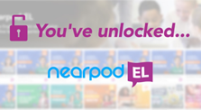 resources such as quizzes, polls, presentations, lessons, and activities in one platform. It is fully integrated with PowerPoint, Google apps, One Drive, Remind, and other commonly used apps. Students anonymity is guaranteed.
resources such as quizzes, polls, presentations, lessons, and activities in one platform. It is fully integrated with PowerPoint, Google apps, One Drive, Remind, and other commonly used apps. Students anonymity is guaranteed.
Using research-based methodology, the app has about 1,000 lessons for ELLs. These cover all ages and levels with standards for every state. Some also feature a competitive game format for quizzes. Each lesson is a segment of about 15-20 interactive slides that focus on different aspects of a single word or phrase such as, “Where is the bus?” for younger students.
The free version contains a few free lessons, which can be copied, but it is generally best for teachers who like to create their own. The next level, for $120 per year, has more creative options including more on the fly activities, individual student reports, virtual field trips, a memory test, and matching pairs. Access to all of the lessons costs $349 per year. Nearpod can be contacted for the price for a school, district, or college. In addition to all the features, the quoted prices include integration with three Learning Management Systems: Canvas, Blackboard or It’s Learning. For lists of features, see https://nearpod.com/pricing. Bundles of up to ten lessons or virtual field trips may also be purchased separately for $14.99-$19.99.
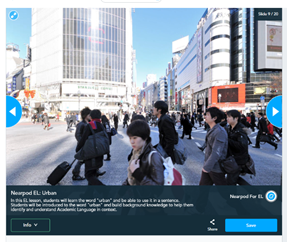 One of the free academic vocabulary lessons for ELLs examines the word, urban. While some of the vocabulary used in the lesson would need to be explained, for example, “facing challenges”, or “an urban setting”, the 360 video of a Tokyo street exemplifies the word perfectly. This free lesson also has a partner activity which asks for other words or pictures to help students remember the word. This is in addition to speaking practice: reading sentences and filling in words and a poll that asks how comfortable the students are with the word. The lesson ends with a Frayer Model Diagram for the teacher.
One of the free academic vocabulary lessons for ELLs examines the word, urban. While some of the vocabulary used in the lesson would need to be explained, for example, “facing challenges”, or “an urban setting”, the 360 video of a Tokyo street exemplifies the word perfectly. This free lesson also has a partner activity which asks for other words or pictures to help students remember the word. This is in addition to speaking practice: reading sentences and filling in words and a poll that asks how comfortable the students are with the word. The lesson ends with a Frayer Model Diagram for the teacher.
For teachers who are looking for a comprehensive platform for learning activities, the site is worth exploring.
Marilyn Pongracz is the Technology Coordinator for NJTESOL/NJBE and the English Language Resource Center Supervisor at Bergen Community College.
Inspirational Egypt: Umm El Doniya
By Natasha Agrawal
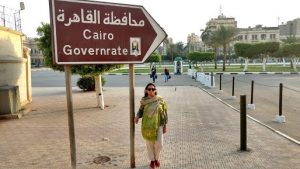 Ahlan Wasahlan! Welcome to Egypt! This phrase is repeated by everyone I meet – street vendors, taxi drivers, co-workers, students. I am amazed to be in this country which calls itself Umm El Doniya, mother of the world. I marvel at the warmth of the people, the beauty of the landscape and the mighty Nile River flowing through the middle of the city. The historic monuments stand shoulder to shoulder with modern skyscrapers. The pyramids remind us science and engineering began here centuries ago. The churches and mosques reveal layer upon layer of history that leaves me dumbfounded.
Ahlan Wasahlan! Welcome to Egypt! This phrase is repeated by everyone I meet – street vendors, taxi drivers, co-workers, students. I am amazed to be in this country which calls itself Umm El Doniya, mother of the world. I marvel at the warmth of the people, the beauty of the landscape and the mighty Nile River flowing through the middle of the city. The historic monuments stand shoulder to shoulder with modern skyscrapers. The pyramids remind us science and engineering began here centuries ago. The churches and mosques reveal layer upon layer of history that leaves me dumbfounded.
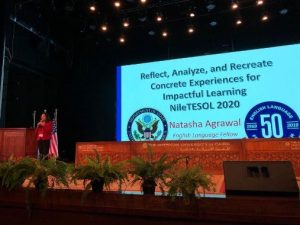 I have been in Egypt as an English Language Fellow for 6 months now. Fellows have the opportunity to teach English, as well as train teachers to teach English. My host institution is Al-Azhar University, the oldest Islamic University in the world. My beautiful classroom is located in the heart of Old Cairo, and my students are the professors and teaching assistants from a variety of departments including mass communication, science, agriculture, Islam, Urdu, and even sports. They are all working on improving their English to apply for programs in the US or UK.
I have been in Egypt as an English Language Fellow for 6 months now. Fellows have the opportunity to teach English, as well as train teachers to teach English. My host institution is Al-Azhar University, the oldest Islamic University in the world. My beautiful classroom is located in the heart of Old Cairo, and my students are the professors and teaching assistants from a variety of departments including mass communication, science, agriculture, Islam, Urdu, and even sports. They are all working on improving their English to apply for programs in the US or UK.
My second teaching job is in an Access class. These students are from ages 13-20. They are usually low-income students who have received a scholarship to attend the Access program which is also run by the Department of State. The youth learn English and many other life skills. Some travel to the US on exchange programs. Egyptian youth are very polite and kind. Most even do their homework!
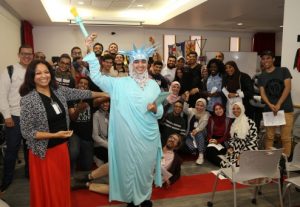 Apart from formal teaching, I host events at the American Center, where Egyptians come to browse the library, use the computers and learn about the United States. Here, I host movie discussions, conversation clubs and holiday events. In addition to these activities, I have had a chance to work with Nile TESOL. This is the Egyptian chapter of International TESOL. I have traveled with Nile TESOL to conduct trainings around the country. In January 2020, it was an honor to give the plenary speech at the annual conference for Nile TESOL with 3000 educators in attendance.
Apart from formal teaching, I host events at the American Center, where Egyptians come to browse the library, use the computers and learn about the United States. Here, I host movie discussions, conversation clubs and holiday events. In addition to these activities, I have had a chance to work with Nile TESOL. This is the Egyptian chapter of International TESOL. I have traveled with Nile TESOL to conduct trainings around the country. In January 2020, it was an honor to give the plenary speech at the annual conference for Nile TESOL with 3000 educators in attendance.
The lingua franca of Egypt is Ameya – which is Arabic in combination with other languages. The language of prayer is Fus’ha, also known as classical Arabic. Being at the eastern tip of Africa, Egypt is a heady mix of Pharaonic, Greek, Roman, Turkish, Mediterranean and colonial influences. While jeans and shirts can be seen everywhere, women’s hair is usually covered with a hijab. Sometimes women wear an abaya, hijab and niqab. Men often wear a long galebiya – almost like a long dress reaching the toes. Local clothes are so appropriate for the desert weather! The melodious call for prayer emanates from the mosques five times each day! The Friday noon prayer is my favorite!
ESL teachers, do apply for such programs which help you develop new perspectives and give you a chance to explore the world! The world is your classroom!
Natasha Agrawal has been an ESL Teacher in Trenton Public Schools since 2008. She has also been an Adjunct Instructor at The College of New Jersey since 2017. She has done presentations at NJ TESOL as well as International TESOL in Philadelphia and Baltimore. In 2018, she was selected by the Department of State as a Teacher for Global Classrooms with a field experience in Morocco. In September 2019, she started her fellowship in Cairo, representing the United States, teaching teens and adults, and training English teachers around Egypt. Agrawal served as an English Language Fellow from 2019-2020. She was assigned to the Regional English Language Office at the US Embassy, in Cairo, Egypt.
What does “to” mean?: Why do the little words matter?
By Jeffrey Linn, Guest Contributor
 I began this inquiry two years ago with the word “the”. I had seen an eight page article on it in school in the 1980s. Eight pages! With no real guidance as to its usages other than to list them. At a linguistics conference in the late 90s I broached the topic with a noted linguist in the Columbia School paradigm. “We haven’t really worked that out,” was his response. The Oxford online entry for the was about 1700 words when I wrote the the paper for this publication. Today, you can find explanatory videos online listing eight rules or so, with various exceptions to each. For a three letter word.
I began this inquiry two years ago with the word “the”. I had seen an eight page article on it in school in the 1980s. Eight pages! With no real guidance as to its usages other than to list them. At a linguistics conference in the late 90s I broached the topic with a noted linguist in the Columbia School paradigm. “We haven’t really worked that out,” was his response. The Oxford online entry for the was about 1700 words when I wrote the the paper for this publication. Today, you can find explanatory videos online listing eight rules or so, with various exceptions to each. For a three letter word.
The Columbia School approach is to investigate Ferdinand de Saussure’s assertion that a language is merely, nontechnically speaking, its words and their meanings. So, I worked along those lines, in my own way, with the goal of getting the most useful meaning-based accounts to share with students of English. A child of five has a fluid mastery of words that are vexing to many an adult language learner. Perhaps part of the explanation for this is not merely the inscrutable facility for language in the child, but that words like set, the, in, to, of, and be have core meanings that are not that different, in nature, from the core meaning of cookie.
We get an awful lot of communicative mileage out of a tiny little word. To is drawn upon very frequently. It is used to construct infinitives, many if not most dative forms, as a preposition in straightforward usages (“driving me to New York”), and also in more nuanced messages, (“driving me to distraction”). Perhaps because to is so versatile, it sometimes winds up almost side by side with itself, in phrases such as “I would like to go to New York”.
We might not notice some cases where to has been deployed until we reflect on its meaning; (let’s suggest “reaching”), as in “reaching night” (tonight) or “reaching the morrow” (tomorrow), or in “reaching a gather” (together).
The standard account of to is to describe its infinitive, dative, and prepositional usages in grammatical terms. But what if we take the approach of attempting to account for its diverse usages with its meaning? If the word has a basic meaning that follows it more or less everywhere, then that would seem a simpler tool for comprehension than searching through a 2,500 word dictionary entry and decoding its arcane grammatical terms.
In order to investigate this possibility, we will need to test our proposed core meaning with usages to see if it makes sense in all or most cases.
And we should craft our best guess at the maximally explanatory core meaning.
In all the languages to which to appears or has appeared, it has more or less meant “in the direction of”. But after looking at a lot of usages of to, we are going to test “reaching”, part of meaning number two in the Google dictionary entry.
We will all need to mention a common use of to where a meaning based account is elusive.
Old English had inflected dative endings on nouns, but during a period of language change the inflected endings began to be de-emphasized and these endings disappeared. The use of to to create dative forms evidently facilitated this process.
The dative marks the indirect object in a sentence, as in:
He gave the pizza to Marcos.
The core meaning of to “reaching” can be sort of extrapolated from its dative use:
He gave the pizza [reaching] Marcos.
But to was also re-purposed to create infinitives. The Etymology Online entry claims to is empty of meaning when used to create the infinitive. It is possible that the core meaning was drawn upon initially in the creation of this new infinitive form, but it is no longer obvious today.
The Cambridge Online Dictionary lists seven definitions of to that are infinitive meanings, but there seems to be not a lot of difference among them. It might suffice to tell students that to is sometimes used to link verbs.
The Cambridge Online Dictionary entry lists 45 examples sentences for to used to create an infinitive, and 86 example sentences where it is not. So, if these numbers mean anything, which they might not, to might be used about 35% of the time to create infinitives.
Of the 86, there are four examples where the “reaching” core meaning is difficult to reconstruct, and the message of to is more like “per”, as in “fifty miles to the gallon”.
But for 82 example sentences, about 63%, if one swaps out “reaching” for “to”, the sentence seems to retain more or less its original message. So, teaching a core meaning of to as “reaching” is potentially helpful to students of English as a clue to meaning in context.
References
Infinitive. Etymology Online. https://www.etymonline.com/word/infinitive
A Short Description of Old English. Thesaurus of Old English (TOE) https://oldenglishteaching.arts.gla.ac.uk/Units/3_Description_of_OE.html
to. The Cambridge Online Dictionary. https://dictionary.cambridge.org/us/dictionary/english/to
to. Etymology Online. https://www.etymonline.com/word/to
to. Lexico. Oxford, https://www.lexico.com/en/definition/to
together. Etymology Online. https://www.etymonline.com/word/together
Jeffrey Linn is a guest contributor for Voices.
